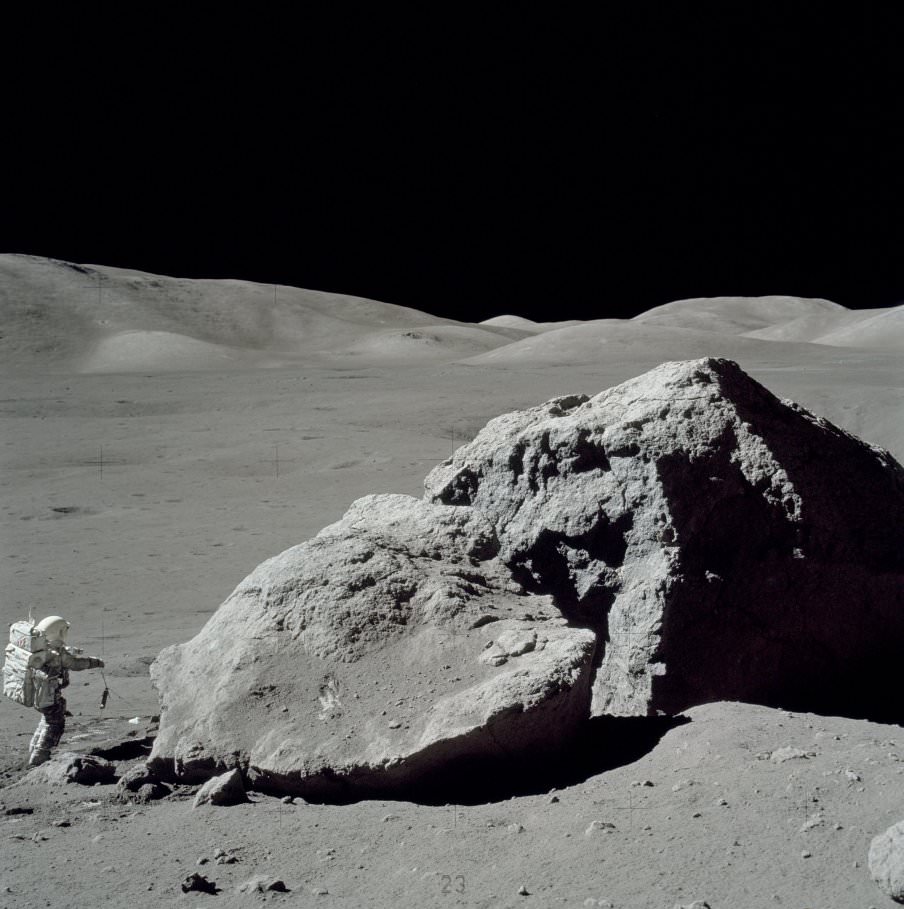In 1982, author James Michener published his sprawling Space Race novel, Space. In it, he describes a fictional Apollo 18 mission to the Moon. While the astronauts are on the surface, the Sun unleashes a huge storm, trapping them outside of their protective capsule. The two men get blasted by lethal amounts of radiation before they can get to safety.
They manage to make it back to their lander but are so sick that they can’t fly back to rejoin their third crewmate in the orbiting lunar command module. They end up crashing back to the surface and dying. As grisly as this sounds, a radiation event like the one in Space poses a very real challenge to space explorers. And, it’s this sort of scenario that lunar mission planners want to avoid. Today, they’re working on ways to mitigate exposure, and, if astronauts do get a dose of radiation, finding medical methods to treat them.
Space Weather and Radiation
Solar outbursts send energetic particles our way via the solar wind every day. They cause space weather, which interferes with communications systems between Earth and the many missions in space (including ISS). It can also seriously disrupt systems here on Earth. Space weather (and the solar storms that cause it) intensify when the Sun is more active, during a period called solar maximum.

Solar storms can range from mild outbursts to significant solar energetic particle events, which can be lethal to humans in space. They happen as proton-laden material bursts out from the Sun, generally associated with big solar flares and coronal mass ejections (CMEs). The particles get accelerated by the flares and CMEs and that’s what makes them so deadly. For astronauts in space, the best protection is to be behind protective walls in their capsules and habitats. But, if it turns out that people on a mission are exposed to radiation, medical procedures to help astronauts recover are important to have.
It’s worth remembering that there has been at least one “close call” with lunar explorers and potential solar activity. In 1972, solar storms blasted out past Earth and the Moon. They disrupted satellite communications as well as ground-based communications systems on Earth. Luckily, no Apollo missions were impacted, although the storms occurred between the Apollo 16 and 17 missions. Had they burst out during those missions, things would have gone badly for the astronauts, who would have been sitting ducks either on their way to the Moon or while on the surface.
Artemis 1’s Radiation Studies
Fortunately, there is a mission to study the radiation environment beyond Earth: Artemis 1. It’s important during this time as we head into solar maximum. When it flies, radiation and medical research will be a major focus of that mission. The Orion capsule has radiation monitors from NASA and ESA on board, along with specialized test mannequins. There are also CubeSats with experiments (such as genetically modified yeast that stands in for human reactions to radiation). These were all designed to study the radiation environment astronauts will face on the way to the Moon.
Orion has radiation shielding, of course, to protect humans and technology. Future craft such as SpaceX’s Human Landing System will be well-shielded to protect astronauts on their way to the Moon and back to the planned Lunar Gateway. In the event of a very severe storm, astronauts could hide in onboard shelters until it’s safe. That’s what ISS crews did when the Sun let loose a particularly fierce outburst in September 2017.
Radiation Hazards Beyond Earth
It’s worth remembering, however, that the ISS is within the protective bubble of Earth’s magnetosphere. Astronauts venturing outside the magnetosphere in Orion or other spacecraft will be at risk. So will people living and working on the Moon. There’s no such magnetospheric protection available “out there.” In a strong solar storm, people in space will get blasted with lethal amounts of radiation very quickly.

“Leaving the magnetosphere is like leaving a safe harbor and venturing out into the open ocean,” said Melanie Heil, Segment Coordinator of the European Space Agency’s Space Weather Office. “Radiation exposure for astronauts at the Moon can be an order of magnitude higher than on the Space Station and several orders of magnitude higher than on Earth’s surface. Future astronauts will face higher risks from solar particle events: it is very important that we study the radiation environment beyond the magnetosphere and improve our ability to predict and prepare for solar storms.”
For its part, ESA is working on the European Radiation Sensor Array (ERSA) project. That’s a series of sensors to give real-time radiation monitoring on board the future crewed lunar Gateway space station. The idea is to get measurements from both inside and outside of crew capsules and habitats to understand radiation risks and leaks. It’s also possible to include radiation sensors on uncrewed lunar orbiters such as Lunar Pathfinder. Another possibility is to put sensors on future lunar telecommunication satellites.
Predicting Solar Activity
In addition to shielding our astronauts and lunar explorers, it’s important to explore the radiation environment between Earth and the Moon as Artemis will do. But, we need more information about the solar outbursts themselves. While astronomers know a lot about solar activity, we still need a solid “early warning system” for solar storms. It could help alert astronauts and lunar explorers in time to take safety measures.
That’s the goal of space weather researchers around the world. Early observation of active regions on the solar disk occur is a major goal of ESA’s 2029 Vigil mission. It will give advance warnings for potentially hazardous space weather events that could endanger astronauts and explorers. Other missions, such as SOHO, STEREO, Solar Dynamics Observatory, and the Parker Solar Probe, provide valuable long-term data about the Sun’s activity.
For More Information
Protecting Artemis and lunar explorers from space radiation
Our Sun
Spaceweather Prediction Center
Space Radiation (HRP Elements)

